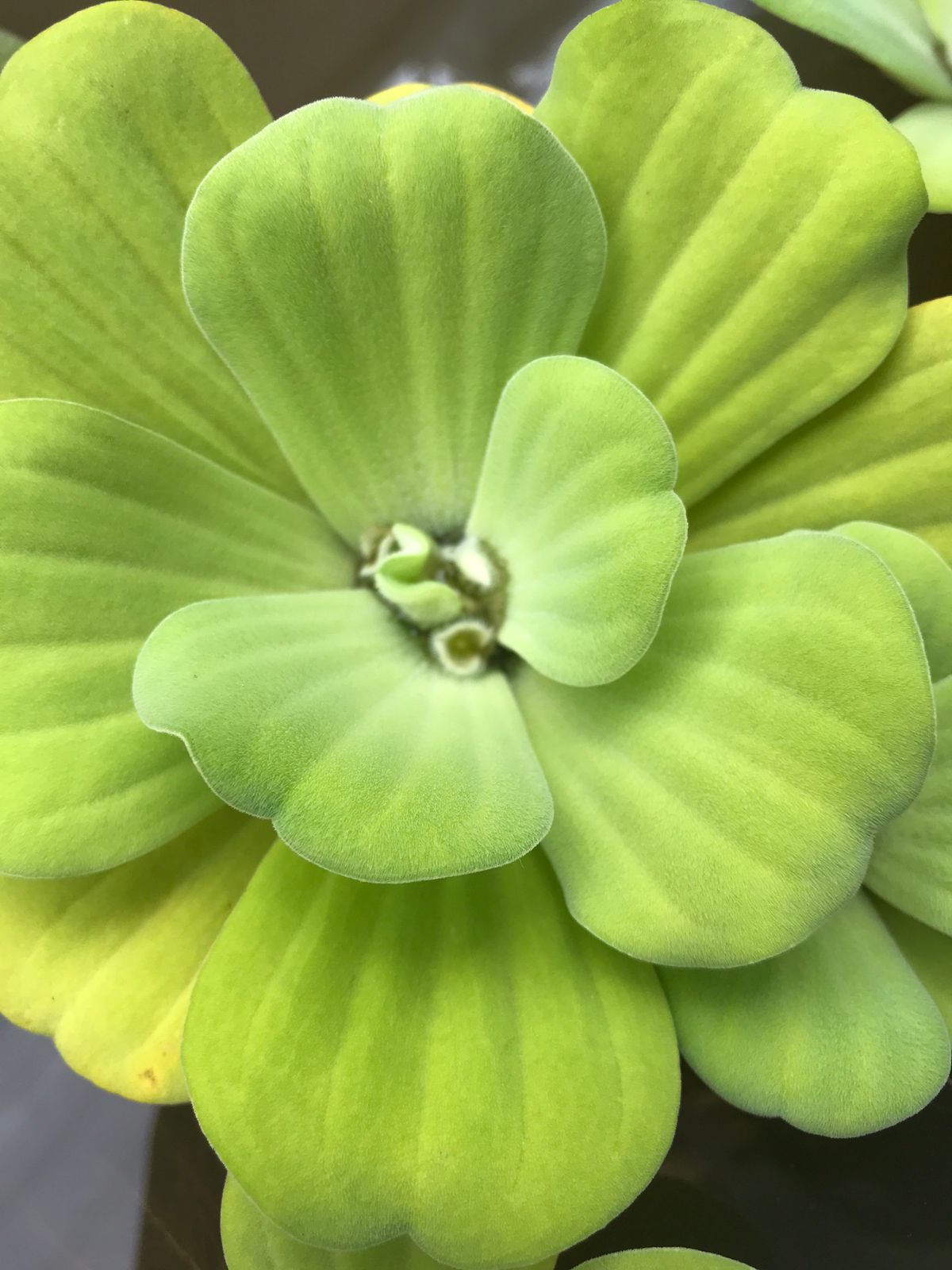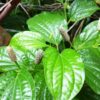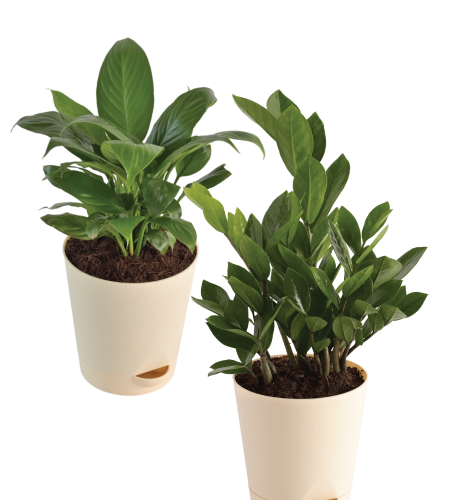Pistia stratiotis (Water lettuce) is a moncotyledon plant that looks like an open head of lettuce floating in water (Ramey 2001). Near the base, the leaves are spongy, with dense soft pubescence on obvious parallel veins (Langeland and Burks 1999). It has gray-green leaves that are about 15 cm long, widest at the apex, and are arranged in rosettes. Rosettes can grow alone or in groups connected by short stolons. The leaf surface is covered in dense white hairs and has prominent parallel veins. Roots are numerous, feathery, and dense, hanging unbranched 50-80 cm below the water’s surface; each root is covered in fine root hairs that give it a feathery appearance. Flowers are hidden in the leaf axils, clustered on small, fleshy stalks. A whorl of male flowers surrounds a single female flower. The female flower produces a green berry with many seeds as the fruit. Environmental conditions and population density have a strong influence on morphological variation (Thompson 2007). Water lettuce is a floating, herbaceous perennial plant found in tropical and subtropical regions around the world. Water lettuce, also known as water cabbage or Nile cabbage, is appropriately named and resembles a head of the leafy greens. Water lettuce was first described around 2,000 years ago along the Nile River. The plant was mentioned in both Ancient Egyptian hieroglyphics and Ancient Greek botanists’ writings. Except for Antarctica, water lettuce has been discovered in bogs, lakes, and marshes on every continent. Water lettuce is popular among those who have water gardens because it prevents algae growth and cleans the water. It has even been shown to be effective in removing heavy metal toxins such as zinc and cadmium from water supplies.
Considerations for Water Lettuce Growth and Hardiness: Water lettuce forms rosettes on the water’s surface and has thick, soft leaves that can grow to be 15 cm (6 in) long. One rosette can grow to be around 30 cm (12 in) in diameter and 10cm in height (4 in). Dense feathery roots extend up to one metre (39 in) below the water’s surface, providing ample shelter for small fish. New growth is typically accompanied by the development of smaller daughter plants that are linked to the original growth via stolons.
Pistia stratiotis (Water lettuce) is a floating perennial plant found in tropical and subtropical regions around the world. It grows best at temperatures ranging from 22 to 30 degrees Celsius (59 degrees Fahrenheit) (72-86o F). This plant is especially sensitive to dissolved minerals, and it requires water with a salt content of 2.5 ppt or less and no lime.
In late summer to early autumn, water lettuce produces small, inconspicuous flowers in the centre of the plant. They produce a large number of seeds that sink to the bottom of the water and survive the winter in temperate climates. Although not winter hardy, water lettuce seeds can survive for two months in water at temperatures of at least 4 o C (39 o F).
Water Lettuce Planting Instructions:
The majority of water lettuce is sold by the head or in small groups. Before planting, any yellow leaves should be removed. Water lettuce can be planted by simply spreading it across the surface of your pond after the last frost of the season in late April. Water lettuce grows best when it is not constantly moved. A floating plastic hoop, fishing line, or rocks can be used to encircle your water lettuce. Although tropical plants, water lettuce grows best in the early summer when temperatures reach at least 15.5 degrees Celsius (60 degrees Fahrenheit). It is a good idea to provide partial shade during peak midday temperatures, especially if you live in a hot climate.
Water Lettuce Maintenance:
Water lettuce grows quickly, so excess plants must be removed to avoid overcrowding and nutrient limitation. There are two approaches that can be taken to accomplish this. Removing the small daughter plants encourages additional growth and is ideal for plant propagation. Removing the larger plants, on the other hand, will slow growth and reduce the amount of maintenance required.
It is advised to bring water lettuce inside during the winter. Place several plants in wet, sandy loam before the first frost and store in a brightly lit area with a temperature of at least 10 o C or 50 o F. Overwintering plants in a clear goldfish bowl filled with rainwater and stored in full sunlight at 50 o F (10 o C) or higher has also been successful for some gardeners.
Water lettuce may consume certain nutrients and begin to turn yellow if a pond is particularly small. There are a few options for dealing with this, including floating the failing plants in dissolved Miracle Grow for several hours, applying the depleted nutrient solution to the pond, and treating the pond with a commercial nutrient booster.
Furthermore, if you use a pond skimmer, make sure that no water lettuce has floated into the system, as this can damage the pump. Pond fish may also consume and kill water lettuce. As a result, containing water lettuce in aquatic baskets or separating the problem fish with a solid boundary may be a good idea.
Is Water Lettuce Harmful or Invasive?
Water lettuce is native to most of the tropical world, but it is considered a pest due to its proclivity for out-of-control growth. Water lettuce can cost an area money by clogging irrigation and drainage systems and preventing boating and fishing access in lakes, canals, and rivers, which are popular tourist destinations. Water lettuce has also been identified as a threat to taro and rice plantations. Severe environmental consequences have also been mentioned. Water lettuce can clog a body of water’s air-water interface, limiting gas exchange and lowering dissolved oxygen levels. Furthermore, the leaves, which are frequently filled with stagnant water, are ideal breeding grounds for mosquitos.
Although there is some debate about whether water lettuce is native to the United States, in 1765, explorer William Bartram described large growths of the aquatic plant obstructing their boat access through a creek. Water lettuce is, however, illegal in the states of Florida, Louisiana, Mississippi, and Texas, as well as the country of New Zealand.
Water lettuce is toxic if consumed by small animals such as pets or children. It contains calcium oxalate, a poisonous compound that burns the mouth and may cause kidney damage.
Will Fish Consume Water Lettuce?
It is unknown which organisms enjoy eating water lettuce. However, many home gardeners have discovered that their fish, particularly koi and goldfish, can kill their water lettuce plants by eating their roots.
What makes water lettuce unique?
Water lettuce is excellent for removing decomposition byproducts from water and is frequently used to keep water healthy for fish and aquatic life. This plant also reduces algae blooms by blocking sunlight in the water and depleting the nutrients required for algae to grow.
Is water lettuce suitable for aquariums?
Water lettuce, despite its reputation, can benefit your pond and aquarium not only because of its pretty green leaves, but also because it will provide a home for your baby fish and shrimps, as well as help clean the water and repel algae. You will only need to check in on them once a week to see if they require additional assistance.
Is lettuce water an oxygenator?
Water lettuce is the most effective oxygenator because it releases oxygen directly into the pond water.









Reviews
There are no reviews yet.